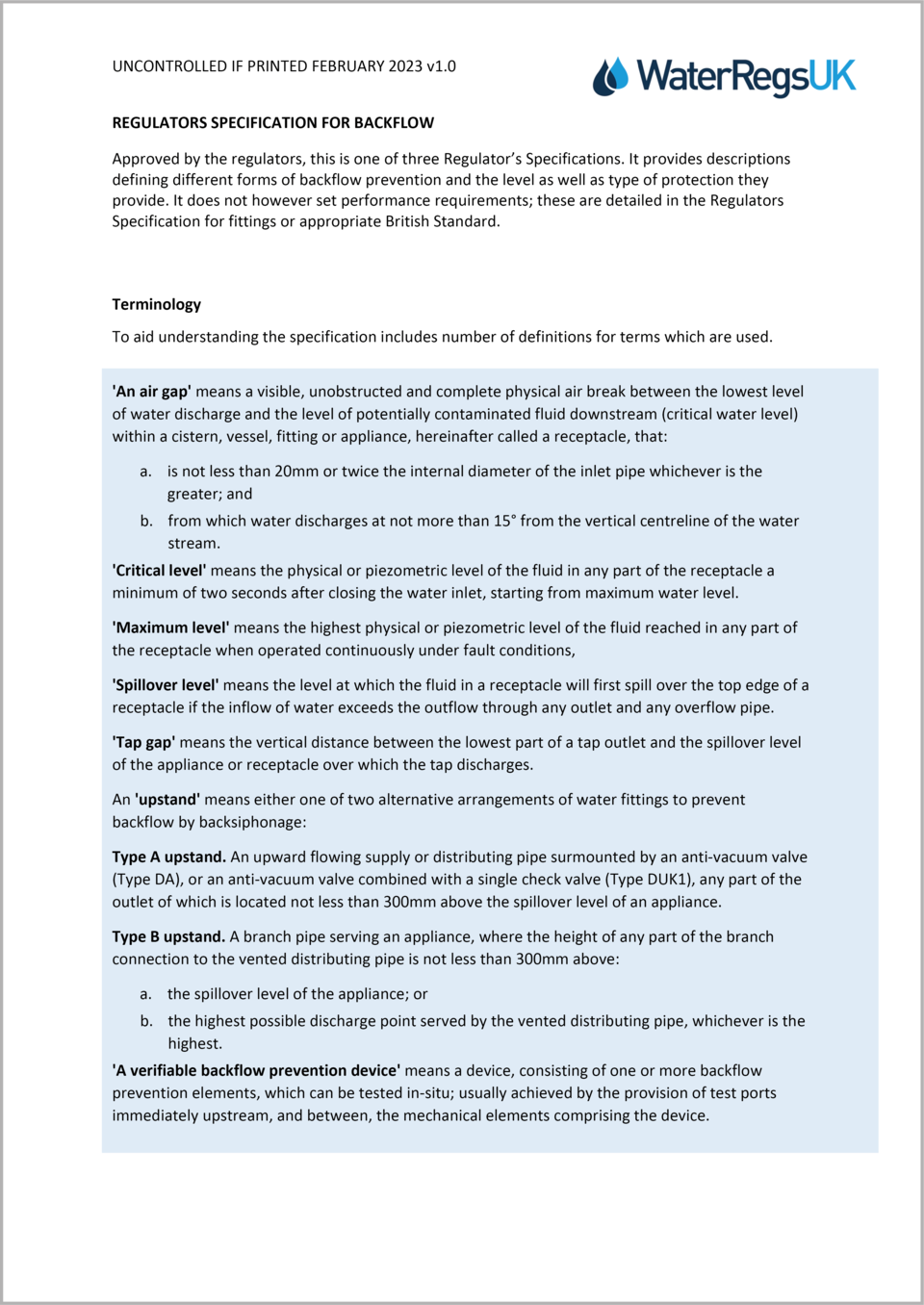Backflow Protection: FAQs
What form of backflow prevention should be installed as point of use backflow protection?
Schedule 2 paragraph 15 of the water fittings regulations in England, Wales and Northern Ireland, byelaws in
Scotland require every plumbing system to incorporate protection against backflow, this is often referred to as point of use backflow protection.

To be accepted as providing adequate backflow protection the backflow device or arrangement installed typically should:
- Firstly be approved by the Regulator or a relaxation to authorise its use granted
- Secondly be rated equal to or higher than the highest contamination risk (fluid category) downstream for the type of backflow (back pressure or back siphonage) a system is likely to be exposed to.
- Thirdly be of an appropriate quality and standard.
As some backflow prevention arrangements and devices have operational limitations you should always check with the local water undertaker to make sure they are suitable for the intended application.
Please note: if high risk contaminants are likely to be present in a plumbing system, because these represent a greater risk to health, in addition to any point of use protection the water undertaker can also require the installation of zone or wholesite backflow protection.
Regulators Specification: Non-mechanical backflow protection | |||
Type | Description | Suitability by fluid category | |
Back pressure | Back siphonage | ||
AA | Air gap with unrestricted discharge above spillover level | 5 | 5 |
AB | Air gap with weir overflow | 5 | 5 |
AC | Air gap with vented submerged inlet | 3 | 3 |
AD | Air gap with injector | 5 | 5 |
AF | Air gap with circular overflow | 4 | 4 |
AG | Air gap with minimum size circular overflow determined by measure or vacuum test | 3 | 3 |
AUK1 | Air gap with interposed cistern | 3 | 5 |
AUK2 | Air gaps for taps and combination fittings (tap gaps) discharging over domestic sanitary appliances, such as a washbasin, bidet, bath or shower tray shall not be less than the following: Size of tap or combination fitting . Not exceeding G ½ Exceeding G½ but not exceeding G ¾ Exceeding G ¾
Vertical distance bottom of tap outlet above spillover level of recieving appliance 20 mm 25 mm 70 mm
| X | 3 |
AUK3 | Air gaps for taps or combination fittings (tap gaps) discharging over any higher risk domestic sanitary appliances where a fluid category 4 or 5 is present, such as:
Shall be not less than 20 mm or twice the diameter of the inlet pipe to the fitting, whichever is the greater | X | 5 |
DC | Pipe interrupter with permanent atmospheric vent | X | 5 |
Notes:
| |||
Regulators Specification: Mechanical backflow protection | |||
Type | Description | Suitability by fluid category | |
Back pressure | Back siphonage | ||
BA | Verifiable backflow preventer with reduced pressure zone | 4 | 4 |
CA | Non-verifiable disconnector with difference between pressure zones not greater than 10% | 3 | 3 |
DA | Anti-vacuum valve (or vacuum breaker) | X | 3 |
DB | Pipe interrupter with atmospheric vent and moving element | X | 4 |
DUK1 | Anti-vacuum valve combined with a single check valve | 2 | 3 |
EA | Verifiable single check valve | 2 | 2 |
EB | Non-verifiable single check valve | 2 | 2 |
EC | Verifiable double check valve | 3 | 3 |
ED | Non-verifiable double check valve | 3 | 3 |
HA | Hose union backflow preventer. Only permitted for use on existing hose union taps in house installations | 2 | 3 |
HC | Divertor with automatic return (normally integral with some domestic appliance applications). | X | 3 |
HUK1 | Hose union tap which incorporates a double check valve. Only permitted for replacement of existing hose union taps in house installations | 3 | 3 |
LA | Pressurised air inlet valve | X | 2 |
LB | Pressurised air inlet valve combined with a check valve downstream | 2 | 3 |
Notes:
| |||
Feedback
To improve this information please give us your feedback >
Disclaimer
Uncontrolled if downloaded. This is informative, non-statutory guidance and intended for general guidance purposes only; it is subject to change.
Compliance with this information should not be relied upon as guaranteeing no enforcement action will be taken by water undertakers. Water Regs UK accepts no liability for loss, indirect or consequential loss arising from or in connection with this guidance document.
